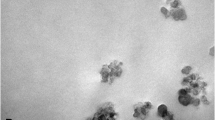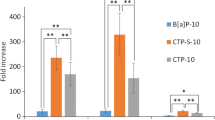Abstract
Many jet fuel aromatic hydrocarbons are known carcinogens with the ability to both readily penetrate the skin with high absorptive flux and cause skin irritation. In order to evaluate the in vitro cutaneous toxicity of individual aromatic hydrocarbons in jet fuels and their potential for inducing skin irritation, we evaluated the LD50, the highest non-cytotoxic (5% mortality) dose (HNTD), and interleukin-8 (IL-8) release activity of nine major jet fuel aromatic hydrocarbons in human epidermal keratinocytes (HEK). LD50 ranged from 1.8 mM (0.03%) for cyclohexylbenzene to 82.9 mM (0.74%) for benzene, with a rank order potency of cyclohexylbenzene >trimethylbenzene ≥xylene >dimethylnaphthalene >ethylbenzene >toluene >benzene. The HNTD values ranged from 0.1 mM (0.001%) for cyclohexylbenzene to 48.2 mM (0.43%) for benzene. Naphthalene and methylnaphthalene could not be ranked in this comparison since their concentrations, presented as percentage saturation, were not comparable to the others presented as solutes in solution. There was a dose-related differential response in IL-8 release at 24 h. Toluene, xylene, trimethylbenzene, cyclohexylbenzene and dimethylnaphthalene significantly decreased IL-8 release at the respective HNTDs, while IL-8 release did not continue to decrease, or significantly increased (cyclohexylbenzene and dimethylnaphthalene), at the LD50. IL-8 significantly increased with both doses of methylnaphthalene and naphthalene. The presence of hexadecane and mineral oil greatly attenuated the cytotoxicity elicited by individual aromatic hydrocarbons in HEK cells.





Similar content being viewed by others
References
Abraham NG (1996) Hematopoietic effects of benzene inhalation assessed by long-term bone marrow culture. Environ Health Perspect 104 [Suppl 6]:1277–1282
Aggarwal BB, Puri KJ (1995) Common and uncommon features of cytokines and cytokine receptors: an overview. In: Aggarwal BB, Puri K J (eds) Human cytokines: their role in disease and therapy. Blackwell, Oxford, pp 1–24
Allen DG, Riviere JE, Monteiro-Riviere NA (2000) Identification of early biomarkers of inflammation produced by keratinocytes exposed to jet fuels jet A, JP-8, and JP-8(100). J Biochem Mol Toxicol 14:231–237
Allen DG, Riviere JE, Monteiro-Riviere NA (2001a) Analysis of interleukin-8 release from normal human epidermal keratinocytes exposed to aliphatic hydrocarbons: delivery of hydrocarbons to cell cultures via complexation with α-cyclodextrin. Toxicol In Vitro 15:663–669
Allen DG, Riviere JE, Monteiro-Riviere NA (2001b) Cytokine induction as a measure of cutaneous toxicity in primary and immortalized porcine keratinocytes exposed to jet fuels, and their relationship to normal human epidermal keratinocytes. Toxicol Lett 119:209–217
Andrew PJ, Harant H, Lindley IJ (1999) Up-regulation of interleukin-1-β-stimulated interleukin-8 in human keratinocytes by nitric oxide. Biochem Pharmacol 57:1423–1429
Barry BW, Harrison SM, Dugard PH (1985) Vapour and liquid diffusion of model penetrants through human skin; correlation with thermodynamic activity. J Pharm Pharmacol 37:226–236
Baynes RE, Brooks JD, Riviere JE (2000) Membrane transport of naphthalene and dodecane in jet fuel mixtures. Toxicol Ind Health 16:225–238
Baynes RE, Brooks JD, Budsab K, Smith CE, Riviere JE (2001) Mixture effects of JP-8 additives on the dermal disposition of jet fuel components. Toxicol Appl Pharmacol 175:269–281
Boman AS (1996) Irritants—organic solvents. In: van der Valk PGM, Maibach HI (eds) The irritant contact dermatitis syndrome. CRC Press, Boca Raton FL, pp 95–104
Borenfreund E, Puerner JA (1985) Toxicity determined in vitro by morphological alterations and neutral red absorption. Toxocol Lett 24:119–124
Brandt HC, Booth ED, de Groot PC, Watson WP (1999) Development of a carcinogenic potency index for dermal exposure to viscous oil products. Arch Toxicol 73:180–188
Broddle WD, Dennis MW, Kitchen DN, Vernot EH (1996) Chronic dermal studies of petroleum steams in mice. Fundam Appl Toxicol 30:47–54
Brooke I, Cocker J, Delic JI, Payne M, Jones K, Gregg NC, Dyne D (1998) Dermal uptake of solvents from the vapour phase: an experimental study in humans. Ann Occup Hyg 42:531–540
Chou CC, Riviere JE, Monteiro-Riviere NA (2002) Differential relationship between the carbon chain-length of jet fuel aliphatic hydrocarbons and their ability to induce cytotoxicity versus interleukin-8 release in human epidermal keratinocytes. Toxicol Sci 69:226–233
Committee on Toxicology (1996) Permissible exposure levels for selected military fuel vapors. National Academy Press, Washington DC
Corsini E, Galli CL (1998) Cytokines and irritant contact dermatitis. Toxicol Lett 102–103:277–282
Corsini E, Galli CL (2000) Epidermal cytokines in experimental contact dermatitis. Toxicology 142:203–212
Dahl AR, Damon EG, Mauderly JL, Rothenberg SJ, Seiler FA, McClellan RO (1988) Uptake of 19 hydrocarbon vapors inhaled by F344 rats. Fundam Appl Toxicol 10:262–269
Dearman RJ, Kimber I (1999) Cytokine fingerprinting: characterization of chemical allergens. Methods 19:56–63
Dudley AC, Peden-Adams MM, EuDaly J, Pollenz RS, Keil DE (2001) An aryl hydrocarbon receptor independent mechanism of JP-8 jet fuel immunotoxicity in Ah-responsive and Ah-nonresponsive mice. Toxicol Sci 59:251–259
Effendy I, Loffler H, Maibach HI (2000) Epidermal cytokines in murine cutaneous irritant responses. J Appl Toxicol 20:335–341
Freeman JJ, Federici TM, McKee RH (1993) Evaluation of the contribution of chronic skin irritation and selected compositional parameters to the tumorigenicity of petroleum middle distillates in mouse skin. Toxicology 81:103–112
Grant GM, Shaffer KM, Kao WY, Stenger DA, Pancrazio JJ (2000) Investigation of in vitro toxicity of jet fuels JP-8 and jet A. Drug Chem Toxicol 23:279–291
Harris DT, Sakiestewa D, Robledo RF, Witten M (1997) Immunotoxicological effects of JP-8 jet fuel exposure. Toxicol Ind Health 13:43–55
Hood RD, Ottley MS (1985) Developmental effects associated with exposure to xylene: a review. Drug Chem Toxicol 8:281–297
Ingram AJ, Phillips JC, Davies S (2000) DNA adducts produced by oils, oil fractions and polycyclic aromatic hydrocarbons in relation to repair processes and skin carcinogenesis. J Appl Toxicol 20:165–174
Jepson GW, McDougal JN (1997) Physiologically based modeling of nonsteady state dermal absorption of halogenated methanes from and aqueous solution. Toxicol Appl Pharmacol 144:315–324
Kabbur MB, Rogers JV, Gunasekar PG, Garrett CM, Geiss KT, Brinkley WW, McDougal JN (2001) Effect of JP-8 jet fuel on molecular and histological parameters related to acute skin irritation. Toxicol Appl Pharmacol 175:83–88
Kalnas J, Teitelbaum DT (2000) Dermal absorption of benzene: implications for work practices and regulations. Int J Occup Environ Health 6:114–121
Kezic S, Monster AC, van de Gevel IA, Kruse J, Opdam JJ, Verberk MM (2001) Dermal absorption of neat liquid solvents on brief exposures in volunteers. Am Ind Hyg Assoc J 62:12–18
Larsen CG, Anderson AO, Oppenheim JJ, Matsushima K (1989) Production of interleukin-8 by human dermal fibroblasts and keratinocytes in response to interleukin-1 or tumour necrosis factor. Immunology 68:31–36
Lindl T, Bauer J (1989) Zell- und Gewebekultur: Einfuhrung in die grundlagen sowie ausgehalte methoden und andwendungen, 2nd edn. Fischer, Stuttgart
McDougal JN, Pollard DL, Weisman W, Garrett CM, Miller TE (2000) Assessment of skin absorption and penetration of JP-8 jet fuel and its components. Toxicol Sci 55:247–255
Monteiro-Riviere NA, Inman AO, Riviere JE (2001) Effects of short-term high-dose and low-dose dermal exposure to jet A, JP-8 and JP-8+100 jet fuels. J Appl Toxicol 21:485–494
Nickoloff BJ, Karabin GD, Barker JNWN, Griffiths CEM, Sarma V, Mitra RS, Elder JT, Kunkel SL, Dixit VM (1991) Cellular localization of interleukin-8 and its inducer, tumor necrosis factor-α, in psoriasis. Am J Pathol 138:129–140
O'Connor SR, Farmer PB, Lauder I (1999) Benzene and non-Hodgkin's lymphoma. J Pathol 189:448–453
Ott RL (1993) An introduction to statistical methods and data analysis, 4th edn. Duxbury Press, Belmont CA, pp 825–831
Rhyne BN, Pirone JR, Riviere JE, Monteiro-Riviere NA (2002) The use of enzyme histochemistry in detecting cutaneous toxicity of three topically applied jet fuel mixtures. Toxicol Mech Methods 12:17–34
Ritchie GD, Still KR, Alexander WK, Nordholm AF, Wilson CL, Rossi J, Mattie DR (2001) A review of the neurotoxicity risk of selected hydrocarbon fuels. J. Toxicol Environ Health B Crit Rev 4:223–312
Riviere JE, Brooks JD, Monteiro-Riviere NA, Budsaba K, Smith CE (1999) Dermal absorption and distribution of topically dosed jet fuels Jet-A, JP-8, and JP-8 (100) Toxicol Appl Pharmacol 160:60–75
Riviere JE, Qiao G, Baynes RE, Brooks JD, Mumtaz M (2001) Mixture component effects on the in vitro dermal absorption of pentachlorophenol. Arch Toxicol 75:329–334
Rogers JV, Gunasekar PG, Garrett CM, McDougal JN (2001) Dermal exposure to m-xylene leads to increasing oxidative species and low molecular weight DNA levels in rat skin. J Biochem Mol Toxicol 15:228–230
Seifert M, Sterry W, Effenberger E, Rexin A, Friedrich M, Haeussler-Quade A, Dieter Volk H and Asadullah K (2000) The antipsoriatic activity of IL-10 is rather caused by effects on peripheral blood cells than by a direct effect on human keratinocytes. Arch Dermatol Res 292:164–172
Tolbert PE (1997) Oils and cancer. Cancer Causes Control 8:386–405
Ullrich SE (1999) Dermal application of JP-8 jet fuel induces immune suppression. Toxicol Sci 52:61-67
Wade LG Jr (1995) Aromatic compounds. In: Wade LG Jr (ed) Organic chemistry. Prentice-Hall, Englewood Cliffs NJ, pp 696
Wester RC, Maibach HI (2000) Benzene percutaneous absorption: dermal exposure relative to other benzene sources. Int J Occup Environ Health 6:122–126
Acknowledgements
This work was supported by the US Air Force Office of Scientific Research F49620-01-1-0080. The authors wish to thank Alfred Inman and Lauren Gast for their technical assistance.
Author information
Authors and Affiliations
Corresponding author
Rights and permissions
About this article
Cite this article
Chou, C.C., Riviere, J.E. & Monteiro-Riviere, N.A. The cytotoxicity of jet fuel aromatic hydrocarbons and dose-related interleukin-8 release from human epidermal keratinocytes. Arch Toxicol 77, 384–391 (2003). https://doi.org/10.1007/s00204-003-0461-z
Received:
Accepted:
Published:
Issue Date:
DOI: https://doi.org/10.1007/s00204-003-0461-z




